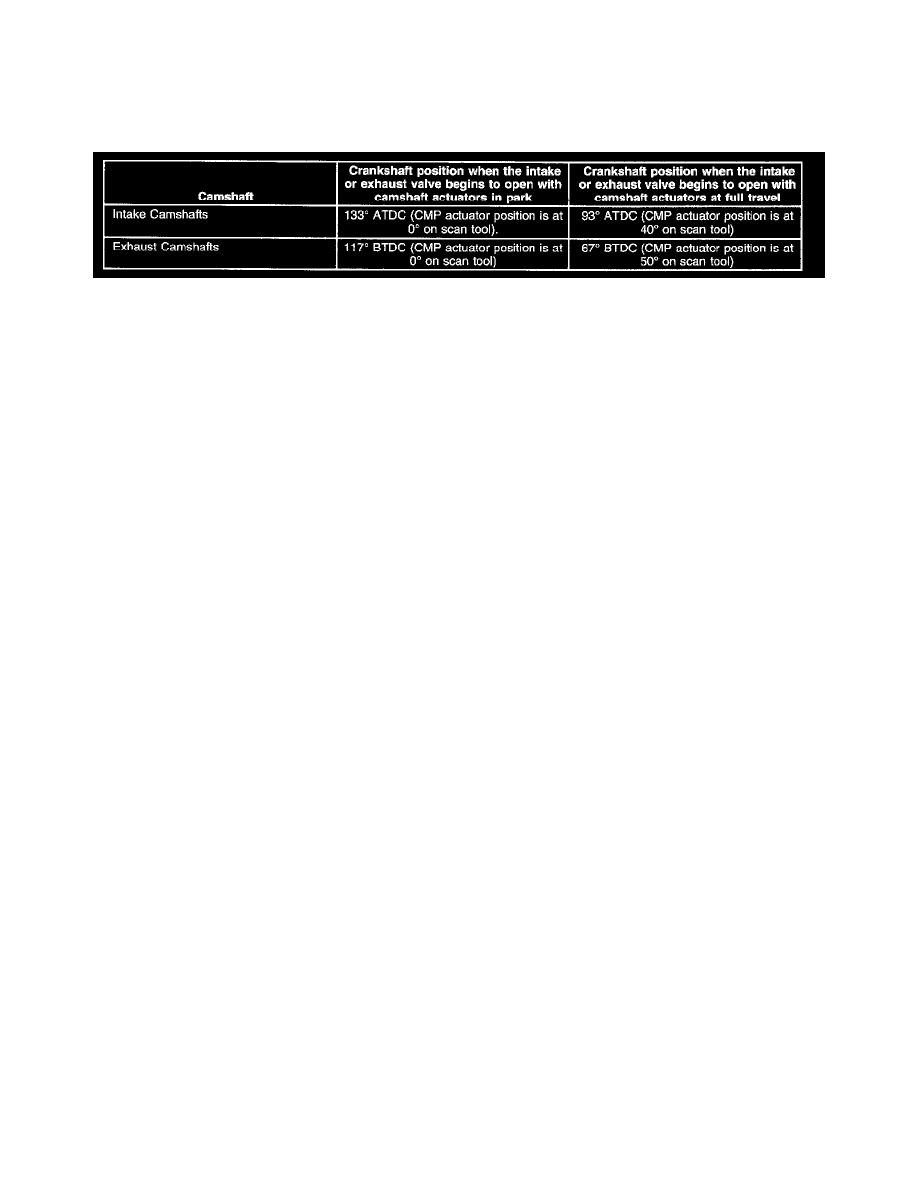SRX AWD V8-4.6L VIN A (2004)

of the exhaust CMP actuators and to the retarding chambers of the intake CMP actuators. With full command from the ECM, all of the oil is ported to
the retarding chambers of the exhaust CMP actuators and to the advancing chambers of the intake CMP actuators. When the intake or exhaust
camshafts reach a desired position, above 0 degrees on the scan tool, the ECM will apply an electrical signal to the solenoids in order to hold the CMP
actuators in the desired position. The oil control valves will port engine oil evenly to the advancing and retarding chambers of the CMP actuators in
order to hold the camshafts in the desired position. The oil control valves will allow enough engine oil to flow to compensate for any leakage past the
CMP actuators in order to hold the camshafts in a steady position.
The CMP actuators interface the timing chain to the camshafts, and are able to change the camshaft timing in relation to the crankshaft. The intake
CMP actuators have the ability to move the intake camshafts a total of 40 degrees from the parked position. The exhaust CMP actuators have the
ability to move the exhaust camshafts a total of 50 degrees from the parked position. With the engine OFF or with the CMP actuators not commanded,
the exhaust CMP actuators are parked at the full advance position of 133 degrees ATDC and the intake CMP actuators are parked at the full retard
position of 117 degrees BTDC. The CMP Angle parameters on the scan tool will indicate 0 degrees with the engine running and the CMP actuators in
the parked position for both exhaust and intake camshafts.
A locking pin keeps the CMP actuators in the parked position in order to avoid valve train noise upon engine start-up. The locking pin will release the
actuator after the engine oil pressure is sufficient to overcome the locking pin spring pressure. The exhaust CMP actuators have return springs. The
return springs are necessary to assist the CMP actuators to return to the parked position due to the rotational inertia of the valve train components upon
engine shutdown.
An oil outlet tube is used to transfer oil from a dedicated oil galley in the engine block, from the replaceable oil filter, up to each head and is located in
the timing chain area. The oil outlet tube incorporates a non-replaceable 40 micron oil filter. If the filter becomes clogged with contamination and can
not be cleaned, the tube and filter must be replaced as an assembly. Engine oil pressure, level, viscosity, and temperature can have an adverse affect on
the CMP actuator performance.
The CMP sensors are used by the ECM to monitor the position of the camshafts. The intake cam sensor wheels have 8X targets. The exhaust cam
sensor wheels have a 1X target. The ECM can detect a camshaft position variance as small as 2 degrees. The variance is the difference between the
actual camshaft position and the desired camshaft position. A CMP actuator performance DTC will set if the ECM detects the camshaft position has a
2 degree to 11 degree variance. A 2 degree variance takes more time for the ECM to detect than an 11 degree variance. A crankshaft to camshaft
correlation DTC will set if the ECM detects a 12 degree variance or more. If a CMP actuator system DTC is present, the ECM will disable the CMP
actuator system control for that ignition cycle.
CMP ACTUATOR SYSTEM OPERATION
The ECM sends an electrical signal to the CMP actuator solenoids through the control circuits when a camshaft timing change is desired. The ground
circuit of the CMP actuator solenoid is used as a return. The CMP actuator solenoid uses electromagnetic force to pull on the plunger of the oil control
valve. The oil control valve will port the pressurized engine oil to either the advancing or retarding chambers of the CMP actuator. The CMP actuator,
in turn, changes the camshaft position relative to crankshaft position. The ECM uses the CMP sensors to determine the position of the camshafts.
The ECM calculates the optimum camshaft position through the following inputs:
-
Engine speed
-
Manifold absolute pressure (MAP)
-
Throttle position (TP) indicated angle
-
Crankshaft position (CKP)
-
Camshaft position (CMP)
-
Engine load
-
Barometric pressure (BARO)
The ECM monitors the following inputs before assuming control of the CMP actuator system:
-
Engine coolant temperature (ECT)
-
Loop status
-
Calculated engine oil temperature
-
Engine oil pressure
-
Engine oil level
-
Crankshaft/camshaft correlation
-
Ignition 1 signal voltage
-
Barometric pressure (BARO)
